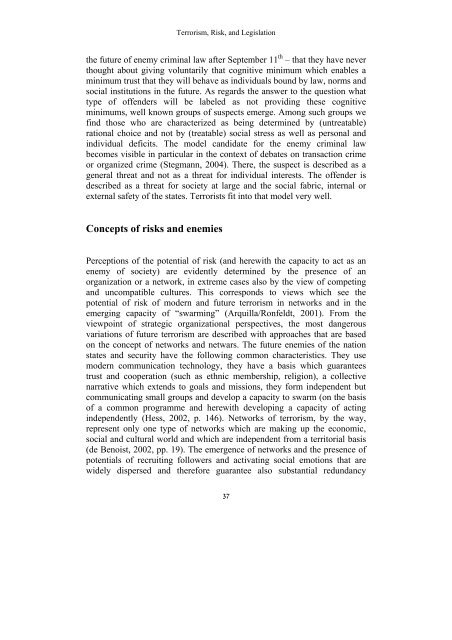222467to222472
222467to222472
222467to222472
You also want an ePaper? Increase the reach of your titles
YUMPU automatically turns print PDFs into web optimized ePapers that Google loves.
Terrorism, Risk, and Legislation<br />
the future of enemy criminal law after September 11 th – that they have never<br />
thought about giving voluntarily that cognitive minimum which enables a<br />
minimum trust that they will behave as individuals bound by law, norms and<br />
social institutions in the future. As regards the answer to the question what<br />
type of offenders will be labeled as not providing these cognitive<br />
minimums, well known groups of suspects emerge. Among such groups we<br />
find those who are characterized as being determined by (untreatable)<br />
rational choice and not by (treatable) social stress as well as personal and<br />
individual deficits. The model candidate for the enemy criminal law<br />
becomes visible in particular in the context of debates on transaction crime<br />
or organized crime (Stegmann, 2004). There, the suspect is described as a<br />
general threat and not as a threat for individual interests. The offender is<br />
described as a threat for society at large and the social fabric, internal or<br />
external safety of the states. Terrorists fit into that model very well.<br />
Concepts of risks and enemies<br />
Perceptions of the potential of risk (and herewith the capacity to act as an<br />
enemy of society) are evidently determined by the presence of an<br />
organization or a network, in extreme cases also by the view of competing<br />
and uncompatible cultures. This corresponds to views which see the<br />
potential of risk of modern and future terrorism in networks and in the<br />
emerging capacity of “swarming” (Arquilla/Ronfeldt, 2001). From the<br />
viewpoint of strategic organizational perspectives, the most dangerous<br />
variations of future terrorism are described with approaches that are based<br />
on the concept of networks and netwars. The future enemies of the nation<br />
states and security have the following common characteristics. They use<br />
modern communication technology, they have a basis which guarantees<br />
trust and cooperation (such as ethnic membership, religion), a collective<br />
narrative which extends to goals and missions, they form independent but<br />
communicating small groups and develop a capacity to swarm (on the basis<br />
of a common programme and herewith developing a capacity of acting<br />
independently (Hess, 2002, p. 146). Networks of terrorism, by the way,<br />
represent only one type of networks which are making up the economic,<br />
social and cultural world and which are independent from a territorial basis<br />
(de Benoist, 2002, pp. 19). The emergence of networks and the presence of<br />
potentials of recruiting followers and activating social emotions that are<br />
widely dispersed and therefore guarantee also substantial redundancy<br />
37


